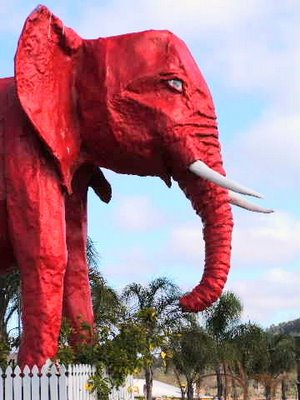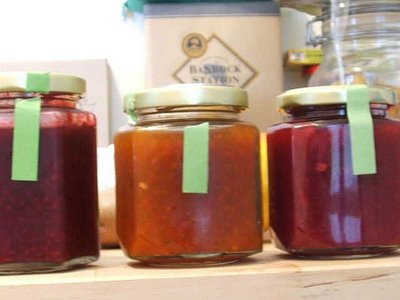
The wrinkled skin of the blushing pachyderm reminds me of papîer maché models of the kind I made in primary school for display in the schools’ exhibition hall at the local agricultural show . The chicken wire frame of the elephant by the roadside is traceable beneath the thin layer of moulded fibreglass, in the same way that the layers of newspaper, glue and paint I helped shape in grade five couldn’t hide the skeletons of Eeyore and Tigger that were constructed in homage to Winnie the Pooh.
 There’s something about the kind of amateur marketing, that this sculpture represents, which is difficult to resist. The elephant is a kind of naïve creative work. I don’t know the history of this elephant, but I’d speculate it wasn’t created by a professional sign-writer or even an artist. I imagine, rather, that it was fashioned by farmers trying to secure a future that farming by itself will no longer afford them.
There’s something about the kind of amateur marketing, that this sculpture represents, which is difficult to resist. The elephant is a kind of naïve creative work. I don’t know the history of this elephant, but I’d speculate it wasn’t created by a professional sign-writer or even an artist. I imagine, rather, that it was fashioned by farmers trying to secure a future that farming by itself will no longer afford them.The red elephant embodies the enthusiastic industriousness that arises at the moment when the family-run roadside store is transformed from a value-added side-line to the main business of crop growing, into a self-contained, profit-making concern. The roadside fruit and vegetable shop that the elephant fronts may well be a response by local producers to unacceptably low prices offered by supermarket chains, who might even have declined to buy their crops, for whatever reason.
The resourcefulness that solves the problem of finding a market for unsold produce is further employed in the creation of sculptures like the elephant, which apply a vernacular knowledge of marketing. It can be no mistake that the elephant is red, rather than grey, which would blend into the landscape, or even pink, that would connote something other than wholesome farm-fresh produce. The elephant has almost certainly been constructed with an awareness of the genre of over-sized roadside sculptures—the big pineapple, the big banana etc.—that seek to entice visitors with farm-grown delights from the farmer’s own work roughened hands
In this instance, the home-made charm of the oversized elephant prefigures the character of what is for sale. Beyond the local farm produce, the shop on the side of the Warrego Highway also offers visitors the unmatched goodness of the country farm kitchen in a range of ‘home-made’ preserves. Upon entering this section of the building, another example of naïve marketing is encountered.
 I liked this elephant the best. Home wood-working skills are in evidence, and the simplicity of the white writing on the red background further feeds the myth of an uncomplicated rural existence in a way that is somehow comforting, even if it is unable to withstand even the slightest interrogation.
I liked this elephant the best. Home wood-working skills are in evidence, and the simplicity of the white writing on the red background further feeds the myth of an uncomplicated rural existence in a way that is somehow comforting, even if it is unable to withstand even the slightest interrogation. I bought three jars: raspberry jam, chilli jam and beetroot chutney. And I got a tropical smoothie as well. I didn’t get a banana one because I thought that surely $4 for anything that includes bananas these days could not be cost effective for the providore.
I bought three jars: raspberry jam, chilli jam and beetroot chutney. And I got a tropical smoothie as well. I didn’t get a banana one because I thought that surely $4 for anything that includes bananas these days could not be cost effective for the providore.
2 comments:
do you remember the giant silver cactus we made?
urban women's craft association = go
yes! I do. Never has there been a more creative use of toothpicks.
Post a Comment